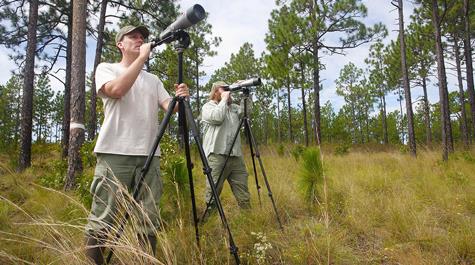Knocking on wood for a successful relocation of rare woodpeckers
Biologists from several agencies and organizations have come together to make preparations for a historic woodpecker translocation, a coordinated effort to move some red-cockaded woodpeckers to the Great Dismal Swamp National Wildlife Refuge. The effort has been years in the making and will attempt to establish a new population of the federally endangered woodpecker on the refuge.
Virginia represents the northern range limit for the red-cockaded woodpecker, and since the early 2000s the state population has been restricted to a single breeding site, Piney Grove Preserve. Intensive habitat management by The Nature Conservancy and population management by the Center for Conservation Biology have brought this population back from two breeding groups in 2002 to 14 breeding groups by 2014. However, concentration of all birds within a single site makes the population vulnerable to a catastrophic event.
Establishment of additional breeding sites has been included in the Virginia red-cockaded woodpecker conservation plan for several years. The plan is to move eight birds, four females and four males, to the Great Dismal Refuge. The birds will be relocated from a population in the Caroline Sandhills National Wildlife Refuge to Great Dismal, which straddles the Virginia-North Carolina border.
Efforts have been ongoing for an extended period of time to prepare for the move. Areas within the Great Dismal Swamp have been identified and managed to receive the birds. Due to the unique requirement of this species for old-growth pine, sites that support adequate cavity and forage trees have been delineated.
These woodpeckers excavate cavities in live pines, a process that may take months to years, so artificial cavities have been installed to assist the birds until they may produce their own. Finally, individual birds have been identified and located within “donor populations” for movement.
Fall represents the normal dispersal period for this species and young-of-the-year males and females will be moved in an “assisted dispersal” to the refuge. Four potential breeding pairs will be moved to “recruitment clusters” that have been prepared to receive them in October.
Moving a species with such specialized requirements is a process that has many moving parts. This effort would not be possible without the collaboration of many great people and institutions that are dedicated to woodpecker recovery.
The U.S. Fish and Wildlife Service, Virginia Department of Game and Inland Fisheries, North Carolina Department of Transportation, The Nature Conservancy, the Center for Conservation Biology, and J. Carter & Associates have all joined forces in the effort.
Bryan Watts is the director of the Center for Conservation Biology, a joint program of Virginia Commonwealth University and William & Mary.















